Unlocking the Potential of Neural Networks in Programming
Neural networks represent a paradigm shift in the world of programming, offering a powerful tool for tackling complex problems that traditional algorithms struggle to solve. Inspired by the structure and function of the human brain, neural networks are at the core of many advancements in artificial intelligence (AI) and machine learning.
What Are Neural Networks?
A neural network is a series of algorithms that seek to recognize underlying relationships in a set of data through a process that mimics how the human brain operates. In essence, these networks are composed of layers of interconnected nodes, or “neurons,” which process data and transmit signals to each other, much like neurons in the biological neural networks.
The Building Blocks of Neural Networks
The basic unit of a neural network is the perceptron, which receives multiple input signals, processes them, and produces an output signal. These perceptrons are organized into three types of layers:
- Input Layer: This layer receives initial data for processing.
- Hidden Layers: One or more hidden layers perform computations using weighted inputs from previous layers and pass results onward.
- Output Layer: The final layer produces outputs based on the computations performed by the network.
The Role of Weights and Activation Functions
In neural network programming, weights are crucial as they determine the influence one neuron has over another. During training, these weights are adjusted to improve predictions or categorizations made by the network. Activation functions come into play as well; they help decide whether a neuron should be activated or not, contributing to the network’s ability to capture complex patterns.
Training Neural Networks
To program neural networks effectively, developers must train them using large datasets. Training involves feeding data into the network and adjusting weights based on errors in predictions. This process is repeated numerous times until the network’s outputs match expected results with acceptable accuracy—a method known as supervised learning.
Backpropagation: The Backbone of Training
The most common training algorithm for neural networks is backpropagation. It works by propagating errors backward through the network after each forward pass—adjusting weights to minimize those errors over time.
Fine-Tuning Through Hyperparameters
Beyond adjusting weights during training, programmers also fine-tune hyperparameters such as learning rate, number of hidden layers, and number of neurons per layer to optimize performance.
Languages and Libraries for Neural Network Programming
To harness these concepts practically, several programming languages offer libraries designed specifically for creating and training neural networks:
- Python: Arguably leading the charge with libraries like TensorFlow and PyTorch that provide flexible platforms for building complex models.
- R: Known for statistical analysis; offers packages such as KerasR and MXNetR for neural networking tasks.
- C++: Provides efficient execution with libraries like Caffe which is particularly good at image processing tasks.
- Java: Although not as prevalent in this space as Python or R, Java has Deeplearning4j which supports various types of deep learning models.
The Future Is Bright With Neural Network Programming
The future possibilities offered by neural networks seem boundless—from revolutionizing medical diagnostics to enabling advanced autonomous systems. As computing power increases and algorithms become more sophisticated, programmers will continue unlocking new capabilities that could transform how we interact with technology—and indeed—the world around us.
7 Essential Tips for Effective Neural Network Programming: From Basics to Advanced Techniques
- Start with simple neural network architectures before moving on to complex ones.
- Understand the mathematical concepts behind neural networks, such as backpropagation and activation functions.
- Preprocess your data properly to improve the performance of your neural network.
- Regularize your neural network to prevent overfitting.
- Experiment with different hyperparameters to optimize the performance of your neural network.
- Visualize the training process and results to gain insights into how your neural network is learning.
- Stay up-to-date with the latest research and trends in neural network programming.
Start with simple neural network architectures before moving on to complex ones.
When delving into neural network programming, it is advisable to begin with simple architectures before venturing into more complex ones. By starting with straightforward neural network structures, programmers can grasp fundamental concepts, understand how different components interact, and fine-tune their skills in training and optimization. This approach not only builds a solid foundation but also helps in troubleshooting and debugging issues effectively as complexity increases. Mastering the basics of simple neural networks lays a strong groundwork for tackling more intricate models with confidence and proficiency.
Understand the mathematical concepts behind neural networks, such as backpropagation and activation functions.
To excel in neural network programming, it is essential to grasp the underlying mathematical principles that drive these powerful systems. Concepts like backpropagation, which fine-tunes network weights through error minimization, and activation functions, which govern neuron behavior, play pivotal roles in shaping the functionality and performance of neural networks. By delving into the intricacies of these mathematical foundations, programmers can gain a deeper understanding of how neural networks learn and make decisions, paving the way for more effective model development and optimization strategies.
Preprocess your data properly to improve the performance of your neural network.
Properly preprocessing your data is a crucial step in enhancing the performance of your neural network. By cleaning, normalizing, and transforming your data before feeding it into the network, you can ensure that the model receives high-quality input that leads to more accurate and efficient predictions. Preprocessing techniques such as scaling numerical features, handling missing values, and encoding categorical variables can help the neural network learn patterns effectively and make better decisions. Investing time and effort in data preprocessing ultimately paves the way for a more robust and reliable neural network model.
Regularize your neural network to prevent overfitting.
Regularizing your neural network is a crucial step in preventing overfitting, a common issue in machine learning where the model performs well on training data but fails to generalize to unseen data. By applying regularization techniques such as L1 or L2 regularization, dropout, or early stopping, you can help your neural network learn essential patterns from the data without memorizing noise, ultimately improving its performance on new and unseen datasets.
Experiment with different hyperparameters to optimize the performance of your neural network.
To optimize the performance of your neural network, it is essential to experiment with different hyperparameters. Hyperparameters, such as learning rate, number of hidden layers, and batch size, play a critical role in determining how well your network learns and generalizes from data. By systematically adjusting these hyperparameters and observing their impact on the network’s performance, you can fine-tune your model to achieve better accuracy and efficiency in solving complex problems. Experimentation with hyperparameters is a key strategy in neural network programming to unlock the full potential of your model.
Visualize the training process and results to gain insights into how your neural network is learning.
Visualizing the training process and results is a valuable tip in neural network programming as it offers a clear window into how the network is learning and adapting to the data. By plotting metrics such as loss and accuracy over epochs, developers can identify patterns, anomalies, and areas for improvement. Visual representations of neural network behavior not only provide insights into model performance but also aid in debugging, fine-tuning hyperparameters, and ultimately enhancing the overall efficiency and effectiveness of the network.
Stay up-to-date with the latest research and trends in neural network programming.
To excel in neural network programming, it is crucial to stay up-to-date with the latest research and trends in the field. As neural networks continue to evolve rapidly, keeping abreast of new techniques, algorithms, and best practices is essential for maximizing the effectiveness and efficiency of your programming efforts. By staying informed about cutting-edge developments, you can leverage the most advanced tools and methodologies to enhance the performance of your neural network models and stay ahead in this dynamic and innovative domain.


